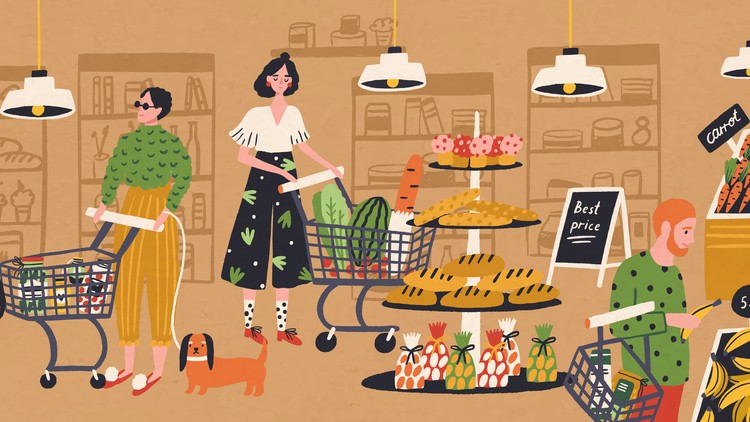Shopper Marketing, Store Design and Visual Merchandising
- Description
- Curriculum
- FAQ
- Reviews
- Grade

Have you ever wondered how stores influence your shopping behavior?
In an age of self-service stores, saturated markets, and ever more demanding customers, the creative and science-driven design of the point of sale has become a crucial success factor for both retailers and service businesses. In this course, you will be introduced to shopper marketing. I will reveal the marketing secrets of how our purchase decisions are influenced by colors, scents, store layouts, and merchandise presentations. You will learn to understand shopping behavior and how to optimize the design of retail stores and service environments to increase customer satisfaction and sales.
Some of the questions addressed in the course are:
-
How can store design trigger impulse purchases?
-
How are visual merchandising and theming used to create irresistible shopping experiences?
-
How can stores be designed to make shopping more convenient for senior citizens?
-
What are the best (and the worst) selling zones in a store?
-
Why are men (but not women) seduced by red sales signs?
The intended audience of the course are entrepreneurs, marketers, and retailers, but also interested consumers who want to learn how shopping behavior can be influenced.
After participating in this course, you won’t ever look at stores the same way again. You will automatically analyze every store you enter to discover the psychological techniques used to make shoppers buy.
-
2Shopper shadowing: Tracking shoppers in the store
-
3Four principles of how shoppers move in the store
-
4Grid and free form: Creating a store layout that suits the store
-
5Follow the yellow brick road: Influencing shopper movement through a loop
-
6How I ended up buying potato chips: Where to place products for purchase
-
7High and low selling zones
-
8Eye level is buy level: The principles of shelf placement
-
9Horizontal, not vertical: Shoppers’ search patterns
-
10Follow the eye: Eyetracking at the Point of Sale
-
11From my bookshelf
-
12Quiz: Shopper movement and instore behavior
-
13Overview of the module
-
14I’m so lost… and I hate this place: The effects of shopper disorientation
-
15It’s all in the head: Improving shopper orientation through cognitive map
-
16The magic number 7: Improving shopper orientation through signs
-
17Find out if your are color blind
-
18Words and pictures: Applying dual coding theory
-
19You are here: Improving orientation through store maps
-
20The store as a forbidden place: Consumer disinformation
-
21From my bookshelf
-
22Quiz: Shopper orientation and disorientation
-
23Overview of the module
-
24Communicating through the senses: How the store atmosphere influences emotions
-
25How the environment influences shoppers: The Mehrabian-Russell-Model
-
26Arousal and pleasure: The key drivers of in-store behavior
-
27Better slow than fast: Using background music in the store
-
28The smell of happy memories: Using ambient scents
-
29Let the sunshine in: Store lighting
-
30Red or blue? Colors in the store
-
31Everything must fit: The importance of congruence
-
32From my bookshelf
-
33Quiz: Influencing shoppers through the store atmosphere
-
34Overview of the module
-
35Seducing shoppers with the merchandise: What is visual merchandising?
-
36Shoppers only buy what they see: The 3 key principles of visual merchandising
-
37Less is more: Avoiding the choice overload effect
-
38Choosing the right company for your products: Bundled presentations
-
39Creating visual magnets: Directing the shoppers’ attention
-
40A picture says more than a thousand words: Using in-store graphics
-
41Close examination of an endcap
-
42From my bookshelf
-
43Quiz: Visual merchandising - the art and science of product presentation
-
44Overview of the module
-
45Competing with cyberspace: Reasons for experiential retailing
-
46Necessity or fun: Utilitarian and hedonic shopping
-
47Pleasure seekers: Creating shopping experiences for hedonic shoppers
-
48Exciting places and live entertainment: Experiences for adventure shoppers
-
49Creating a third place: Designing experiences for social shoppers
-
50Gifts and curiosity: Experiences for role, gratification, and idea shoppers
-
51Appealing to bargain hunters: Designing experiences for deal-prone consumers
-
52Jungles, castles and Harry Potter: Creating effective themed experiences
-
53From my bookshelf
-
54Quiz: Making shopping fun through experiential store design
-
55Overview of the module
-
56How much longer? Shorten consumers’ wait-time perceptions
-
57Influencing wait time perceptions at the checkout
-
58Expensive or cheap? Influence shoppers’ price perceptions
-
59Accessibility for all: Design the store for senior citizens
-
60Wait, wait, don’t go! Keep shoppers in the store longer
-
61I must have that! Encourage impulse purchases
-
62Make shopping simple and fun: The importance of processing fluency
-
63Quiz: Recipes for influencing shoppers












